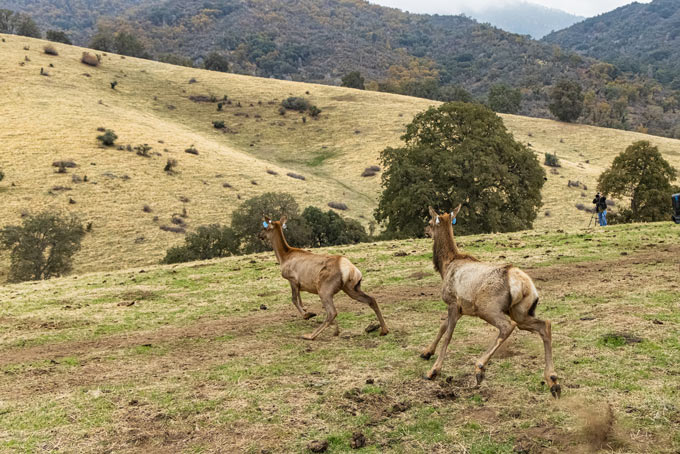What you need to know: The largest ancestral land return in the Sierra Nevada foothills and the Central Valley, and the reintroduction of tule elk, restores cultural connections, strengthens sovereignty, and advances California’s 30×30 goals.
October 29, 2025 - SACRAMENTO – In a historic milestone, Governor Gavin Newsom today announced the return of 17,030 acres of ancestral land to the Tule River Indian Tribe. This is the largest ancestral land return in the Sierra Nevada foothills and Central Valley region, and a milestone in California’s efforts to address historical wrongs against California Native American tribes, as well as in the state’s work to restore and protect critical ecosystems. A land return and tule elk reintroduction ceremony will be held today with tribal leaders, state partners, and community members in attendance.
The historical wrongs committed by the state against the Native people of this land echo through the natural worlds of California — ecosystems that lost their first and best stewards. Today marks a critical step in deepening the relationship between the state and the Tule River Indian Tribe, and works towards restoring the deep relationship between the Tribe and their ancestral lands.
Governor Gavin Newsom

This land return and tule elk reintroduction restores sacred homelands, renews access to traditional foods and medicines, and strengthens cultural continuity for future generations. It was done in partnership with the Tribe, California Natural Resources Agency (CNRA), Wildlife Conservation Board (WCB), the California Department of Fish and Wildlife (CDFW), and facilitated by The Conservation Fund (TCF), and was funded through CNRA’s Tribal Nature-Based Solutions grant program, WCB’s Habitat Conservation Fund, and private philanthropic partners. The Tribal Nature-Based Solutions grant program builds on the Governor’s direction for state entities to work cooperatively with California Native American tribes to return ancestral lands and advances one of the core pillars to partner with tribes in the state’s goal to conserve 30% of California’s lands and coastal waters by 2030.
“The Tule River Tribe has a long history of asserting and affirming its sovereignty,” said Tule River Tribal Council Chairman Leister “Shine” R. Nieto Jr. “This land return demonstrates the very essence of tribal land restoration, which expands access to essential food and medicinal resources. It also supports the ongoing preservation of cultural sites, deepens environmental stewardship, and restores wildlife reintroduction efforts. The Tribe envisions this land located in the Yowlumne Hills as a place to gather, heal, and simply be, for members of the Tule River Indian Tribe. We extend our sincere thanks to the CNRA, WCB, philanthropic partners, and The Conservation Fund for their generous support of this land return.”
This land acquisition builds on the Tribe’s efforts to advance sovereignty, restore habitat, and honor the enduring connection to their lands and culture. Once spanning over 91,000 acres, the reservation today includes more than 55,000 acres of forest and rangeland.
Return of Tule Elk, restoration of ecosystem
In partnership with CDFW, the Tribe will reintroduce tule elk that have been absent from the foothills for decades to help restore the land’s ecological community, which has seen a resurgence of gray wolves. Last year, the Tribe and CDFW also partnered to reintroduce beavers into the area. The partnership between CDFW and the Tribe will also sustain the recovery of the California condor and protect important habitat — setting a model for future tribal and state collaboration.
The Tule River Indian Tribe land acquisition safeguards vital watersheds that support downstream communities, wildlife, and agricultural lands, and reconnect landscapes between the Giant Sequoia National Monument, the Tribe’s reservation, and San Joaquin Valley wetlands, advancing California’s goal to conserve 30% of the state’s lands and coastal waters.
“This land return reflects the very best of California, honoring tribal leadership, reintroducing keystone wildlife, and investing to help people and nature thrive together,” said California Natural Resources Agency Secretary Wade Crowfoot. “The return of tule elk to these foothills shows what is possible when cultural resilience and conservation come together to build a healthier, more just California. Moving forward, we are charting a future in which tribal leadership guides all we do to protect our lands, waters, and wildlife.”
Restoration will also improve groundwater recharge, reduce flood risks, and secure water supplies for downstream disadvantaged San Joaquin-Tulare communities. By healing watersheds, enhancing resilience, and expanding cultural access, this project delivers benefits far beyond tribal boundaries, creating lasting protections for people, wildlife, and lands across the region.
As part of similar, larger efforts to help restore and rehabilitate ecosystems across the state, including initiatives to return salmon to habitats, CDFW and its partners have initiated a second year of spring-run Chinook salmon reintroduction efforts into historic habitat in the North Yuba River.
habitats, CDFW and its partners have initiated a second year of spring-run Chinook salmon reintroduction efforts into historic habitat in the North Yuba River.
Source: Office of the Governor



